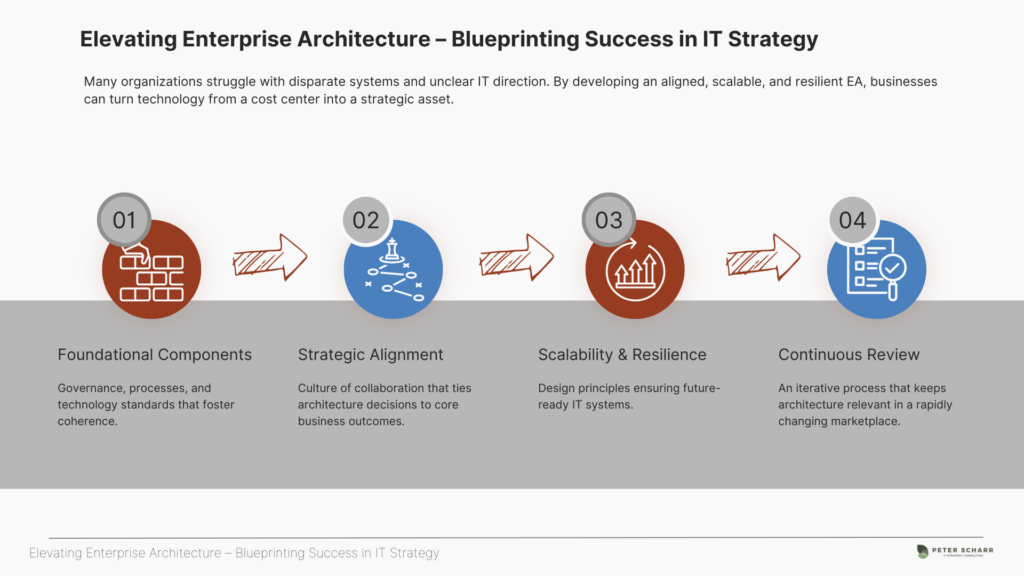Starting with a Fresh Blueprint: The Role of Enterprise Architecture
Enterprise architecture (EA) is the overarching framework that connects an organization’s business objectives with its information technology capabilities. Think of it as the master plan that ensures every piece of the IT puzzle functions in harmony toward a shared goal. Its purpose is to clarify how different systems, processes, and technologies should be organized to promote collaboration, reduce inefficiencies, and ultimately further strategic initiatives.
This architectural perspective carries immense weight in today’s tech-driven marketplace. By defining clear structures for data exchange, application interoperability, and governance, a solid EA shapes IT as a proactive force rather than a reactive support function. In many ways, enterprise architecture is the compass that points organizations to more innovative and flexible paths in an ever-changing environment.
This blog post aims to show you how a well-crafted EA can guide your IT strategy, pave the way for efficient business transformation, and ensure that every technological decision supports the broader corporate vision. Together, we’ll explore foundational components, discuss alignment with core business goals, and look at real-world examples to solidify our understanding.

Laying the Cornerstones: Key Components for a Solid Foundation
Effective enterprise architecture starts by defining critical building blocks. Chief among these components are:
- Governance: Clear policies and guidelines around decision-making and stewardship ensure consistency across projects.
- Processes and Standards: Agreed-upon frameworks for development, integration, and deployment often form the bedrock of implementation success.
- Technology Choices: Selecting the right platforms, tools, and infrastructure directly impacts performance, security, and future agility.
- Information Flows: Data is the backbone of modern enterprises, making streamlined data management and access a critical priority.
Bridging Vision and Reality: Aligning EA with Business Goals
Enterprise architecture should not exist in a vacuum; it thrives when coordinated with strategic objectives. By pinpointing the specific business outcomes that IT solutions must produce—such as quicker response times, enhanced customer experiences, or cost optimizations—EA professionals can tailor roadmaps to address these ambitions directly.
According to McKinsey’s perspectives on digital transformation, organizations that integrate architecture planning with corporate strategy experience fewer project overruns and misalignments. This synergy encourages continuous adaptation, making technology an enabler of distinct competitive advantages rather than an isolated cost center.
Preparing for the Unexpected: Scalability, Agility, and Resilience
Today’s business environment demands systems that can adapt to volatile market conditions. An architecture that embraces modular designs, flexible integrations, and automated workflows is more likely to scale easily and pivot in response to new challenges. Cloud-based solutions, microservices, and containerization enable enterprises to expand capacity on demand while maintaining robust performance.
Resilience is also crucial. Clusters of redundancies and disaster recovery plans prevent catastrophic disruptions. By embedding agility and resiliency into the core architecture, organizations can confidently innovate without fearing downtime or system collapse.
Finding a Way Through the Maze: Common Challenges and Pitfalls
No journey is free of obstacles. Overzealous dependencies on legacy systems, siloed teams resistant to change, and ambiguous organizational structures frequently hinder architecture initiatives. Sometimes, leadership lacks clarity on just how transformative a well-designed EA can be, causing underinvestment or piecemeal deployment.
Another potential pitfall is overcomplicating the architecture—incorporating unnecessary layers or tools can create more confusion than solutions. A Deloitte report highlights that thorough planning, stakeholder engagement, and ongoing governance help organizations overcome these pitfalls effectively. Address challenges promptly, and an EA program becomes a launchpad for innovation rather than another roadblock.
When Architecture Achieves Mastery: Real-World Narratives
Some of the most striking examples of EA success come from organizations that dared to modernize their infrastructures in pursuit of business goals. For instance, a global financial institution revamped its integration layers to provide real-time data analytics for portfolio management, significantly improving customer satisfaction. Another case involves a logistics firm aligning its internal applications to optimize fleet management, resulting in markedly lower operational costs.
From these accounts, it’s clear that enterprise architecture done right nourishes seamless teamwork and a celebrated culture of innovation. A thoughtful, strategic approach reduces complexity, accelerates market responsiveness, and fosters an environment where technology and business strategies mutually reinforce each other.
Elevating Enterprise Architecture for the Long Haul
Robust enterprise architecture delivers measurable value by streamlining processes, unifying data flows, and aligning IT objectives with high-level strategies. When organizations treat EA as a living roadmap, they stand a better chance of capitalizing on emerging opportunities and mitigating unseen risks.
To continue harvesting these benefits, leaders should provide actionable support—appointing dedicated governance teams, investing in cross-functional collaboration, and periodically reviewing the EA roadmap for relevance. With technology evolving at warp speed, ongoing evaluation ensures your architecture remains responsive, modern, and value-focused.
Ultimately, the key to EA’s lasting success is an iterative mindset. Periodic reviews prevent stagnation and keep your enterprise agile. By watching market trends and internal growth, you’ll be able to adjust your architecture to meet the challenges of tomorrow as effectively as you conquer those of today.
Keeping the vision alive,


